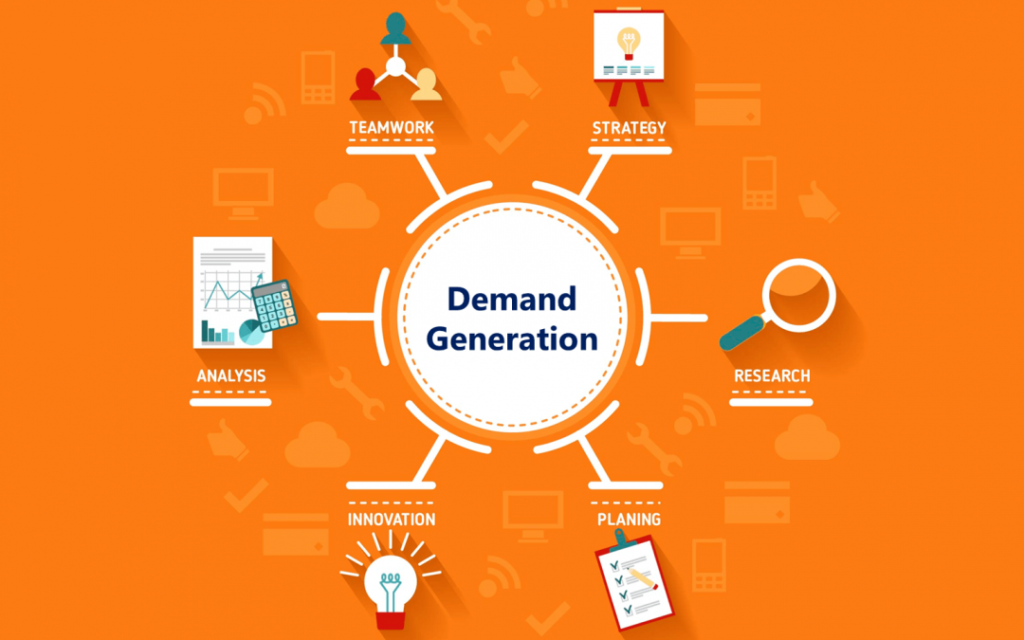Pursuing name or brand recognition and seeking impactful connections with others has always been the vanguard of business leaders and marketers. The endeavor began in fledgling form and has evolved into today’s essential protocol of multifaceted marketing to engage quality leads that can be converted to sales, known as Demand Generation.
Nearly a century in the making, the early mantra, “Win Friends and Influence People” verged on an initial reputation of being almost too avantgarde. But, when the mindset swiftly took hold, it became a roadmap for the ambitious that led to global acquaintance with relationship-building and, eventually, branding.
This preliminary networking mentality was an awakening that morphed into yesteryear’s traditional public relations, involving business leaders’ strategic efforts to create mutually beneficial associations, productive forms of public influence and dynamic methods for communications management.
As many business to business marketers know, present-day marketing is breaking the mold with modernized, innovative and strategic approaches for merging marketing activities and sales goals. These demand generation tactics involve meticulously tracing the customer journey from peaked interest in a service or product to initial engagement with a brand, and onto pipeline, affinity and, ultimately, conversion.
Supply and Demand or Demand and Supply?
For those who begin and end their days with the responsibility of Marketing Communications or the charge to oversee the ways in which Public Relations begets leads and prospects, never have there been quite so many challenges as the current time. The day-to-day expectations are steep. Top of mind and listed on nearly every agenda are Search Engine Results, click-through rates, brand persona, and earned-owned-paid media, all while collecting, measuring and reporting data-driven analytics that make a real difference in the bottom line.
Admittedly, many marketers agree it can be easy to get caught up in the mounting marketing tasks waiting for their boxes to be checked before looming deadlines. Also, up front and center, current events are unearthing our well-made business plans for the new year and a new decade.
Notwithstanding, this can be a time of active evolution and positive progression for brands and businesses. For the go-getter and ever-determined marketers, challenges bring about change, and change engenders solutions.
A proactive shift in thinking and a close look at the overarching objective for most any business to business marketing strategy reveals the core of marketing: Creating interest in and generating demand for products and/or services.
There is undeniably much involved in the sales and marketing process; however, whether products or services, producing demand for available supply is where it all begins.
Demand Generation: Defined.
What is Demand Generation?
The first tangible result of successful marketing is gleaning the interest and attention of qualified leads. Think about the utter power of quality leads versus the volume of leads. Start with this as your initial target mindset, conceptualizing it as the warm-up sprint. View it as the starting line to build long-term business to business relationships.
Having vetted the inherent meaning of “Demand Generation,” Eberly & Collard Public Relations defines it as the inventive and strategic practice of creating interest in and demand for a business’ products and/or services.
Managing business to business Demand Generation involves Lead Generation tactics that engage or enlighten company leaders, decision-makers, buyers, or vendor procurement managers with supportive and nurturing content. This is an element of Lead Generation vs. Demand Generation. The concept is to garner the attention of targeted sales prospects by offering information and edification to solve problems or issues they are facing.
This is with the all-important assumption the prospect or lead and the marketer are both fully cognizant of the problem, and the marketer’s solution will provide unique insight, ideas and support in the form of usable assets.
Everyone with business to business sales goals to meet has interest in simplifying their internal processes, uncovering tricks-of-the-trade, streamlining or minimizing action items that stand in the way of progress, and sourcing content that informs and improves results. Demand Generation strategies allow you to be their new go-to source of valuable, need-to-know information.
Our own offered helpmate, take a look at these brainstormed ways to kick-off Demand Generation marketing for your products and/or services.
1.) Define and Resonate.
While product manufacturers or professional service providers often think they have a clear understanding of their clients, it is worth remembering target audiences and market segments constantly change. Annual or quarterly customer and lead category assessments, combined with competitive intelligence studies, maintain valuable intel that can be put to work in making more productive connections.
Product marketing and professional services public relations are based upon a close union between brands and their customers and clients. Knowing in-depth information about them is essential.
Defining the personas of existing and potential clients, along with the context in which they work, is critical in understanding their needs. Staying in tune with the challenges and issues they experience yields a host of ways to help them, while introducing your brand. This should already be a component to your business to business public relations strategies.
Create a scheduled content strategy to distribute information, white papers, templates, infographics, industry trends, sector-focused data charts and graphs, royalty free photos, unique ideas, newsletters, blogs, and other solutions that will engage and draw them to your business.
Self-publish, post, send, and give away these in-demand resources, and suddenly your business and brand will become a paramount resource for leads and prospects.
2.) Appeal and Delight.
If your business to business marketing strategy does not include Demand Generation, chances are the foundation of your inbound marketing is cracked. Because Demand Generation produces awareness and interest in a business’ existence, thought-leadership and expertise, the core of Demand Generation is the precursor to inbound leads.
Everyone prefers to procure professional services or purchase products from businesses and people they like and trust. When there are multiple competitive options from which to choose, buyers are going to sign contracts or place orders with those whom they believe are most appealing. If a marketable service or product holds comparative value, or even sometimes is a close runner-up, decision-makers will be led to give their business to the provider that satisfies or gratifies them the most.
Since your frequent customer and lead category assessments will reveal your audience’s needs, create tools and materials of value that provide equipage or data to address their challenges. Make a practice of this in lieu of sending continuous, overly promotional offers to your targets. Appealing resources lead to higher open-email rates than repetitive promo offers, every time.
Think of this as the phrase to cultivate and nurture new contacts or those long-time qualified leads who are just not yet ready to become a client. Give them reasons to keep your social media channels and blog in their feeds. Entertain and, yes, entice them by surprising them with the unexpected article or research study you think they may find interesting.
Use the plug-ins and prompting tools in your Customer Relationship Management (CRM) system to follow-up. Go for the long throw, and maximize the enterprise applications focused on customer and lead management, analytics applications and marketing automation.
3.) Pain Points and Healing.
What does a Demand Generation manager do? He or she provides an advanced and gratis healing effect to subdue the common “pains” of potential customers or clients.
Among oversight of marketing strategy, Demand Generation leaders use their skillsets to harvest and develop short-term interactions with contacts and prospects, with the goal of converting them to leads and new customers or clients. They do so by offering attention-grabbing, curative assets and informational collateral.
They do not, however, assume their target audiences are itching to buy their products and/or services. Rather, Demand Generation managers build website traffic and incoming volume of inquiries, which are established by sparking the attention and earning the trust of targeted business to business contacts.
The concept resides in the model that indirect outreach often speaks louder than the direct, at least at the onset. When it comes to being successful in B2B marketing, communicating solutions rather than product lists or service descriptions has an astounding power to build brand reputation and win new business.
Assuming your CRM program is used to add, track, monitor, and foster your prospects, the next step is to point out that you understand the pain points that keep them up at night. When you communicate your understanding of the business struggles with which they deal on a day-to-day basis, a personalized link is established.
Couple this with the courtesy of pertinent case studies, provisional theories and your mindful interpretation of the situation with high-level acuity. Act with the “4-S” principle: Support them by supplying a sampling of your serviceability; then, rinse and repeat. In many cases, they will be all ears.
4.) Reach and Rescue.
An unequivocal way to make your Demand Generation strategy produce results is reaching targets with screen time. Find them where they dwell. Now, more than ever, the majority of business professionals seek resources, data and suppliers of products and services online.
Work with your in-house team and demand generation agency to produce informative videos that highlight trends or subject-matter from your internal thought-leaders. Convey categorically distinctive insights and relevant commentary from an analyst perspective.
Take this a step deeper to plan and host a webinar series. Envision the goal of connectivity; when it makes sense, think beyond the masses. It is wise to invite segmented contacts specific to intentional webinar topics that echo your ingenuity, and reinforce the originality of your products and/or service. Safeguard each presentation’s theme holds unparalleled value to the audience. Videos and webinars should clearly offer relatable knowledge, viewpoints and anecdotes backed by data and research findings.
Record the webinars and supplement them with audio podcasts or video podcasts, making them available online. Distribute them via email campaigns with graphically designed landing pages, inviting recipients to download them. During and following campaign deployment, maintain an easy-to-find “Ask us questions” or “Connect with us now” online chat option. Utilize social media channels and blog posts rife with link-backs to germane pages of your website.
Enlist your sales, marketing and leadership teams as well as your public relations firm to collaborate in developing real-time video, webinar and podcast strategies, as the amalgamation of concepts and angles will prove far more effective than going it alone.
Screen time is key, but combining all forms of digital marketing with creative advertising and innovative publicity is the means to a rock-hard, integrated approach.
Manufacturing these beneficial resources opens the door to reaching potentially qualified leads, and delivering them as accessible commodities offers a form of rescue for those in need of such content.
Leads and Order.
There are numerous ways to increase business to business leads. Known lead generation strategies range from optimizing content that informs and engages possible prospects, to investing in automation technology and enacting outbound and inbound marketing. All deserve careful consideration and credence as part of the process, as long as they are accomplished in order of viability.
Start with solid footing. These four proven strategies to increase sales are the underpinning and groundwork for evoking Demand Generation.



